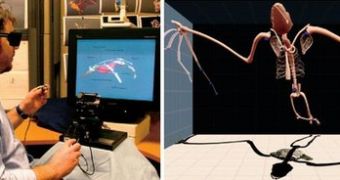You may know that an illustration is bidimensional, but with a virtual reality mask, a stylus in one hand and a tracking device in the other, now drawing as a process has entered the 3D era. The technology is called "Drawing on Air," and helps artists create images of complicated artistic, scientific, and medical subjects.
There are drawing techniques employing virtual reality that allow artists to draw rough sketches, but Drawing on Air brings this to a new level of control. "First, think about a curve found in some interesting 3D shape-the handlebar of a road bike is a good example because it follows a smooth 3D curve," co-author Daniel Keefe, computer scientist and artist at Brown University told PhysOrg.com.
"Take your index finger and try to trace a curve out in the air. If you were able to leave a trail of paint behind your finger as it moves through the air, what you would notice from this exercise is that drawing a nice shape is really hard to do. First, you would probably notice that your drawing is quite wobbly. Second, you would probably find that the 3D proportion of the form is off."
But Drawing on Air offers guidelines, feedback, and two-handed interaction for precise movements. The system sends the 3D drawing to the computer and it will be used in 3D modeling, design, and illustration programs. The two-handed method relies on "tape drawing", a method for drawing in 2D. The stylus in one hand draws while the tracker (assessing the virtual reality setup) in the other hand heads the line.
The coordination of the movement of both hands allows the assessment of the work from different sides. Haptic effects help artists predict and correct line thickness by applying pressure against a virtual 3D surface, which makes drawing in the air a process similar to that of painting with a paintbrush on a paper.
A test made on 12 trained artists revealed that the technique was easy to learn and highly controllable, delivering complex images of 3D subjects. Biologists investigating bat flight got accurate 3D illustrations, extremely precious as bats have a flexible patagium (wing membrane) and curved bones that bend during flight. The tested artists could successfully draw bats relying on information from a bat tested in a wind tunnel, showing anatomical details in motion, and simplifying the body parts of least concern. "If we can boost the precision with which scientists can interact with their 3D data using a computer, then many more scientific uses for virtual reality technology may become possible," said Keefe.
"Right now, the cost is prohibitive, but with the advent of technologies like camera-based 3D tracking, I would expect the cost to create two-handed input systems like this to come down from thousands of dollars to hundreds of dollars in the next few years."

 14 DAY TRIAL //
14 DAY TRIAL //